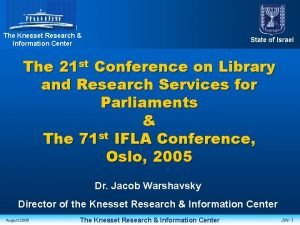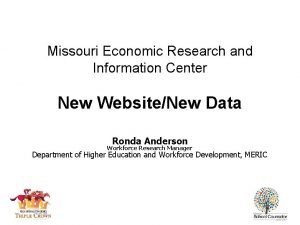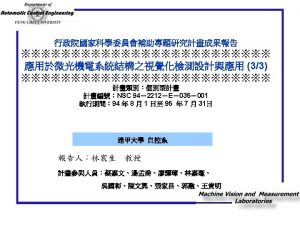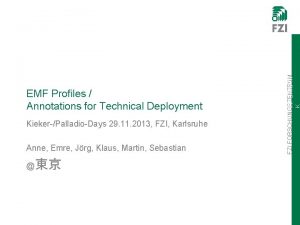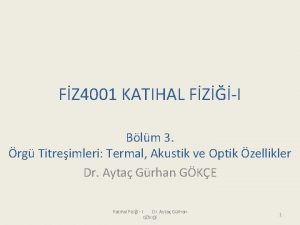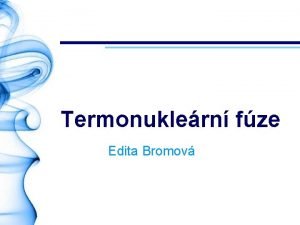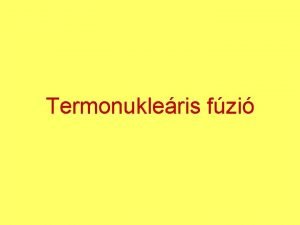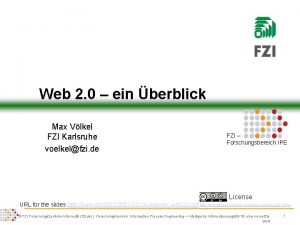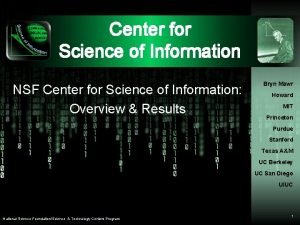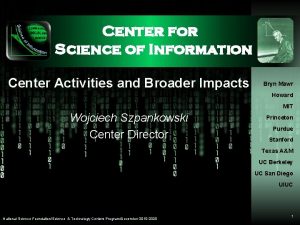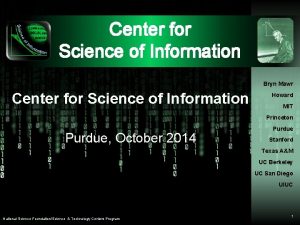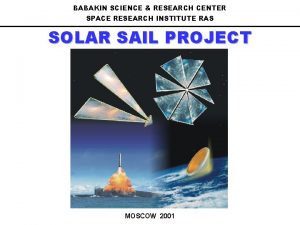FZI Research Center for Information Science at the






















- Slides: 22

FZI Research Center for Information Science at the University of Karlsruhe Variance in e-Business Service Discovery Stephan Grimm, Boris Motik, Chris Preist (HP Labs, Bristol) Forschungszentrum Informatik, Karlsruhe

Overview • Introduction • Intuition behind modelling service semantics • Operationalising discovery using logic • Matching service descriptions • Conclusion Slide 2

Service Discovery in the Semantic Web • Service – Web Service vs. high-level e. Business Service • Service Discovery – Locating Providers who meet a Requestor´s needs – Based on Semantic Descriptions of Services • Semantic Description of a Service – Describing the Capabilities of the Service – Using ontology languages, such as OWL – Referring to common domain ontologies Slide 3

Overview • Introduction • Intuition behind modelling service semantics • Operationalising discovery using logic • Matching service descriptions • Conclusion Slide 4

Service Description – Service Instance set of accepted Service Instances Shipping containers from UK to Germany describes Service Description item shipping 1 from Plymouth to Bremen package. X weight 50 kg item shipping 2 from Dover to Hamburg barrel. Y weight 25 kg . . . Service Instances Slide 5

Variance in Service Descriptions • Two kinds of variance in service descriptions – due to intended diversity – due to incomplete knowledge Shipping to Germany different service instances . . . to Bremen shipping 1 to Bremen shipping 2 to Hamburg shipping 3 to Boston . . . shipping 1 different possible worlds . . . Slide 6

Discovery by Matching Service Descriptions • Matching Service Descriptions of Requestors an Providers – How do their Service Descriptions intersect ? Sr (Sr)I ∩ (Spi)I ≠ Ø S pi Service Requestor S p 1 . . . Service Providers S pn • If there are common instances, requestor and provider can (potentially) do business with each other Slide 7

Overview • Introduction • Intuition behind modelling service semantics • Operationalising discovery using logic • Matching service descriptions • Conclusion Slide 8

Intuition ↦ DL • Service Description ↦ set of DL axioms D={ 1, . . . , n} – A service concept S occurring in some i • Domain Knowledge ↦ DL knowledge base KB Slide 9

Intuition ↦ DL • • • Possible World ↦ Model I of KB ∪ D Service Instance ↦ relational structure in I acceptable Service Instances ↦ Extension SI of S Variance due to intended diversity ↦ |SI| ≥ 1 Variance due to incompl. knowl. ↦ several Models I 1, I 2, . . . Matching ↦ boolean function match(KB, Dr, Dp) – way of applying DL inferences (Package)I 1 (Sr)I 1 (City)I 1 from item (Package)I 2 (Sr)I 2 item from (City)I 2 (UKCity)I 1 . . . (UKCity)I 2 Slide 10

Towards Intuitive Modelling Primitives Characterising Property Restrictions • Variety – fixed value – value range • Availability – Mandatory – obligatory • Multiplicity – single-valued – multi-valued • Range Coverage – Covering – non-covering Slide 11

Overview • Introduction • Intuition behind modelling service semantics • Operationalising discovery using logic • Matching service descriptions • Conclusion Slide 12

Treating Variance in Matching • Resolving Incomplete Knowledge – holds in every possible world : Entailment KB ∪ Dr ∪ Dp ⊨ ⊨ sat. ⊑ ⊓ – holds in some possible world : Satisfiability KB ∪ Dr ∪ Dp ∪ { } sat. • Resolving Intended Diversity – Request and Capability overlap : Non-Disjointness = Sr ⊓ Sp ⋢ ⊥ – Request more specific than Capability : Subsumption = Sr ⊑ Sp – Capability more specific than Request : Subsumption = Sp ⊑ Sr Slide 13

DL Inference for Matching • Satisfiability of Concept Conjunction ) I 1 (Sp)I 2 (Sr)I 1 (Sr)I 2 (Sp X (Sr ⊓ Sp) is satisfiable w. r. t. KB ∪ Dr ∪ Dp ⊨ sat. ⊑ ⊓ . . . • (Sr)I ∩ (Sp)I ≠ Ø in some possible world • Intuitiuon: – incomplete knowledge issues can be resolved such that request and capability overlap Slide 14

Satisfiability of Concept Conjunction • Example: X ⊨ sat. ⊑ ⊓ (Sr ⊓ Sp) is satisfiable w. r. t. KB ∪ Dr ∪ Dp (UKCity)I (USCity)I • match(KB, Dr, Dp. A) = true • match(KB, Dr, Dp. B) = true (Sr Plymouth (City)I Dublin )I (Sp. A)I from (Sp. B)I – UKCity ⊓ USCity ⊑ ⊥ is not specified in KB Slide 15

DL Inference for Matching • Entailment of concept subsumption X ⊨ sat. KB ∪ Dr ∪ Dp ⊨ Sr ⊑ Sp (Sp)I 1 (Sr ) I 1 ⊑ ⊓ (Sr)I 2 (Sp)I 2. . . • (Sr)I (Sp)I in every possible world • Intuition: – the request is more specific than the capability regardless of how incomplete knowledge issues are resolved Slide 16

Entailment of Concept Subsumption • Example: X ⊨ sat. ⊑ ⊓ KB ∪ Dr ∪ Dp ⊨ Sr ⊑ S p (UKCity)I (Sp. A)I Plymouth • match(KB, Dr, Dp. A) = false (City)I Dublin from (Sr)I – Dublin outside the UK Slide 17

DL Inference for Matching • Entailment of Concept Non-Disjointness KB ∪ Dr ∪ Dp ⊨ Sr ⊓ Sp ⋢ ⊥ (Sp)I 1 (Sr)I 2 X ⊨ sat. ⊑ ⊓ (Sp)I 2 (Sr)I 1 . . . • (Sr)I ∩ (Sp)I ≠ Ø in every possible world • Intuition: – the request and the capability overlap regardless of how incomplete knowledge issues are resolved Slide 18

Entailment of Concept Non-Disjointness • Example: X ⊨ sat. ⊑ ⊓ KB ∪ Dr ∪ Dp ⊨ Sr ⊓ S p ⋢ ⊥ (UKCity)I (USCity)I • match(KB, Dr, Dp. A) = true • match(KB, Dr, Dp. A) = false (City)I (Sr)I Plymouth Dublin (Sp. A)I from – Plymouth outside the US in at least one possible world (Sp. B)I Slide 19

Practicability of Inferences • Satisfiability of Concept Conjunction – very weak : vulnerable to false positive matches – relies on additional disjointness constraints in domain ontologies • Entailment of Concept Subsumption – Very strong : misses intuitively correct matches • Entailment of Concept Non-Disjointness – Tries to overcome deficiencies of the other two inferences – relies on range-covering property restrictions (problematic to express in DL) Slide 20

Ranking Service Descriptions • Ranking based on Partial Subsumption (Sp. A)I (Sp. B ⊓ Sr)I (Sp. B)I ⇒ D p. A ≼ D p. B (Sp. A ⊓ Sr)I • DL Inference KB ∪ Dr ∪ Dp. A ∪ Dp. B ⊨ (Sp. A ⊓ Sr) ⊑ (Sp. B ⊓ Sr) Slide 21

Conclusion • Provided an intuitive semantics formal • • • Service Descriptions based on Service Instances Emphasized the meaning of variance in Service Descriptions Mapped intuitive notions to formal elements in DL Investigated different DL inferences for matching Service Descriptions Showed how variance can be treated during matching Proposed a ranking mechanism based on partial subsumption of Service Descriptions Slide 22
 My favourite subject is science because
My favourite subject is science because Knesset research and information center
Knesset research and information center Missouri economic research and information center
Missouri economic research and information center Fspos
Fspos Novell typiska drag
Novell typiska drag Tack för att ni lyssnade bild
Tack för att ni lyssnade bild Vad står k.r.å.k.a.n för
Vad står k.r.å.k.a.n för Varför kallas perioden 1918-1939 för mellankrigstiden?
Varför kallas perioden 1918-1939 för mellankrigstiden? En lathund för arbete med kontinuitetshantering
En lathund för arbete med kontinuitetshantering Adressändring ideell förening
Adressändring ideell förening Vilotidsbok
Vilotidsbok Anatomi organ reproduksi
Anatomi organ reproduksi Förklara densitet för barn
Förklara densitet för barn Datorkunskap för nybörjare
Datorkunskap för nybörjare Stig kerman
Stig kerman Att skriva en debattartikel
Att skriva en debattartikel För och nackdelar med firo
För och nackdelar med firo Nyckelkompetenser för livslångt lärande
Nyckelkompetenser för livslångt lärande Påbyggnader för flakfordon
Påbyggnader för flakfordon Formel för lufttryck
Formel för lufttryck Offentlig förvaltning
Offentlig förvaltning Kyssande vind
Kyssande vind Presentera för publik crossboss
Presentera för publik crossboss

